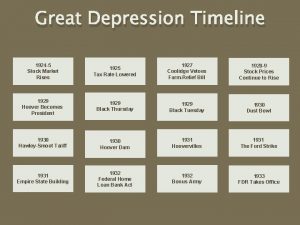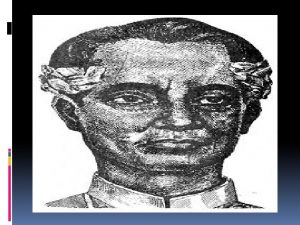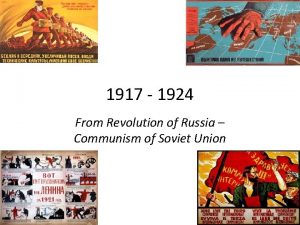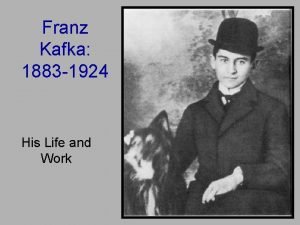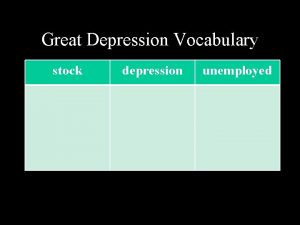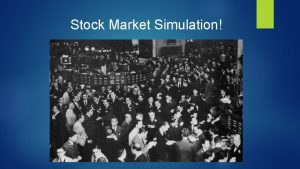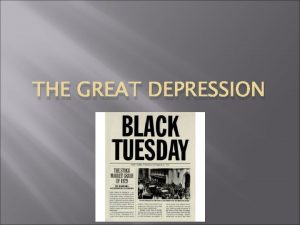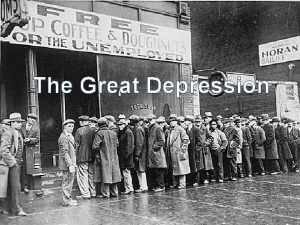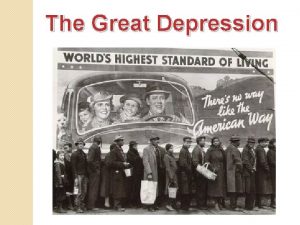Great Depression Timeline 1924 5 Stock Market Rises

















- Slides: 17

Great Depression Timeline 1924 -5 Stock Market Rises 1925 Tax Rate Lowered 1927 Coolidge Vetoes Farm-Relief Bill 1928 -9 Stock Prices Continue to Rise 1929 Hoover Becomes President 1929 Black Thursday 1929 Black Tuesday 1930 Dust Bowl 1930 Hawley-Smoot Tariff 1930 Hoover Dam 1931 Hoovervilles 1931 The Ford Strike 1931 Empire State Building 1932 Federal Home Loan Bank Act 1932 Bonus Army 1933 FDR Takes Office

1924 -5 Stock Market Rises Fed by the optimism of the age, a “get-richquick” attitude prevailed during the 1920 s. The dizzying climb of stock prices encouraged widespread speculation, the widespread practice of making high-risk investments in homes of getting a high gain. Before WWI only the wealthy played the stock market. Now, the press reported stories of ordinary people who had made fortunes. Small investors entered the market, often with their life savings. To attract less-wealthy investors, stockbrokers encouraged a practice called buying on margin. It allowed investors to purchase a stock for only a fraction of its price (10 -50%) and borrow the rest. Brokers charged a high interest and could demand payment of the loan at any time. But if the stock price went up, borrowers could sell at a price high enough to pay off the loan and interest charges and still make money. Timeline

1925 Tax Rate Lowered The top tax rate fell to 25%, on income over $100, 000. Businessmen would be able to see these cuts passing through the political process, and would actually react before their formal enactment. By 1926 65% of the income tax revenue came from incomes $300, 000 and higher, when five years prior, less than 20% did. During this same period, the overall tax burden on those that earned less than $10, 000 dropped from $155 million to $32. 5 million. This policy reduced public debt (largely inherited from WWI obligations). Timeline

1927 Coolidge Vetoes Farm-Relief Bill Farm prices were high during the war and just afterward. But when the wartime demand ended, prices, especially for wheat and cotton, plummeted. During the good times, many farmers had purchased the new tractors and other machinery now available. This allowed them to put more land under cultivation, so they bought more land as well Falling farm prices made farmers unable to repay their debts for their land machinery. Congress responded with the Mc. Nary-Haugen farm relief bill, a measure designed to increase the price farmers received for their crops. Congress passed the bill twice, but President Coolidge vetoed it both times, believing that it was not the government’s job to provide such assistance. Timeline

1928 -9 Stock Prices Continue to Rise In early 1928 the Dow Jones Industrial Average (an index of figures indicating the relative price of shares on the New York Stock Exchange, based on the average price of selected stocks), had climbed to 191. By Hoover’s inauguration day, March 4, 1929, it had risen another 122 points. On September 3, the Dow Jones reached an all-time high of 381. Timeline

1929 Hoover Becomes President When Coolidge chose not to run in 1928, Hoover won easily, benefiting from his years of prosperity under the Republicans. A self-made millionaire, Hoover was widely admired for the way he had organized food relief in Europe during and after WWI. He had also been an effective Secretary of Commerce for Presidents Harding and Coolidge. People expected that good times would get even better under Hoover. Timeline

1929 Black Thursday On Thursday, October 24 th, the market lost 11% of its value at the opening bell on very heavy trading. Several leading Wall Street bankers met to find a solution to panic and chaos on the trading floor. Vice president of the Exchange, Richard Whitney, was chose to act on their behalf. He placed a bid to purchase a large block of Shares in U. S. Steel at a price well above current market. As traders watched, he then placed similar bids on other “blue chip” stocks. He succeeded in halting the slide, with the Dow closing the day down just 6. 38 points. Timeline

1929 Black Tuesday On October 28 th (Black Monday), more investors decided to get out of the market, and the slide continued with the Dow dropping 13%. The next day (Black Tuesday), about 16 million shares were traded, and the Dow lost an additional 30 points, or 12%. Rumors that President Hoover would not veto the Hawley-Smoot Tariff Act were the main reason for investors trading stocks. The volume of stocks traded on Black Tuesday was a record that would not be broken for another 40 years. Timeline

1930 Dust Bowl A period of severe dust storms causing major ecological and agricultural damage to the American prairie lands. This was caused by severe drought coupled with decades of extensive farming without crop rotation, fallow fields, cover crops, or other techniques to prevent wind erosion. Deep plowing of the virgin topsoil of the Great Plains had displaced the natural deep-rooted grasses that normally kept the soil in place and trapped moisture even during periods of drought and high winds. Soil dried up and turned to dust, and blew away eastward and southward in large dark clouds. At times, the clouds blackened the sky, reaching all the way to NYC and Washington DC. 100, 000 acres of farmland were affected by the Dust Bowl. Timeline

1930 Hawley-Smoot Tariff Trying to protect domestic industries from foreign imports, in 1930 Congress passed the Hawley-Smoot Tariff, the highest import tax in history. The tariff backfired. European countries raised their own tariffs, bringing a sudden slowdown in international trade. Timeline

1930 Hoover Dam People wanted to irrigate low lying plains, known as low desert areas, without suffering from flooding and the battle over water made it obvious to the U. S. government that the Colorado River was part of the solution. Six of the largest construction companies worked together to acquire the bid. This sealed the deal and construction began in 1931 with workers from all over the country. Over one hundred lives were lost working on the dam. Timeline

1931 Hoovervilles The hardest hit were those at the bottom of the economic ladder. Some unemployed laborers, unable to pay their rent, moved in with relatives. Others drifted. In 1931, the homeless in NYC alone was at 15, 000. Homeless people sometimes built shanty towns, with shacks of tar paper, cardboard, or scrap material. These shelters of the homeless came to be called Hoovervilles, mocking the President, whom people blamed for the crisis. Timeline

1931 The Ford Strike Three thousand unemployed workers march on the Ford Motor Company’s River Rouge plant in Detroit, Michigan. Dearborn police and Ford’s company guards attack the workers, killing four and injuring over 60 more, many by gunshot wounds. This was called The Ford Hunger March, because workers were literally starving, and this eventually led to the unionization of the U. S. auto industry Timeline

1931 Empire State Building The excavation of the site began on January 22, 1930, and construction on the building itself started on March 17. The Project involved 3, 400 workers, mostly European immigrants, along with Mohawk iron workers. Five deaths were recorded during the construction of the world’s tallest building (at the time). There was stiff competition between the ESB, 40 Wall Street, and the Chrysler Building for the title. Due to reduced costs during the Depression, the final costs $24. 7 million ($372. 8 million today), and was finished three months ahead of schedule. Timeline

1932 Federal Home Loan Bank Act An act passed by the Hoover administration in 1932 that was designed to encourage home ownership by providing a source of low-cost funds for member banks to extend mortgage loans. The Federal Home Loan Bank Act was the first in a series of bills that sought to make home-ownership a more achievable goal for more Americans. Timeline

1932 Bonus Army 20, 000 jobless WWI veterans and their families encamped in Washington D. C. The Bonus Army, as they called themselves wanted immediate payment of a pension bonus that had been promised for 1945. The House of Representatives agreed, but the Senate said no. Most of the Bonus Army then went home, but a few thousand stayed, living in shacks. Timeline

1933 FDR Takes Office Roosevelt called for “a reappraisal of values” and controls on business, and easily won the presidency by 7 million popular votes. The famous words of FDR’s inaugural address renewed hope in the country, “So first of all let me assert my firm belief that the only thing we have to fear is fear itself. ” Having overcome fear in his own life many times, FDR spoke with conviction and confidence, reassuring a frightened nation. Timeline
 Stock market crash 1929 great depression political cartoon
Stock market crash 1929 great depression political cartoon What caused the dust bowl
What caused the dust bowl Great stock market crash 1929
Great stock market crash 1929 Leader challenger follower nicher
Leader challenger follower nicher International market segmentation
International market segmentation Vicente do rêgo monteiro cubismo
Vicente do rêgo monteiro cubismo 1924-1953
1924-1953 Alfred marshall (1842-1924)
Alfred marshall (1842-1924) What credential is issued by the danb
What credential is issued by the danb 1883-1924
1883-1924 1924-1883
1924-1883 A wise economist asks a question meaning
A wise economist asks a question meaning Tagapamagitan sa dalawang nagtatalo
Tagapamagitan sa dalawang nagtatalo Marxists.org
Marxists.org Stalin becomes dictator
Stalin becomes dictator Franz kafka geboren
Franz kafka geboren Rjwg
Rjwg 1923 1924
1923 1924

